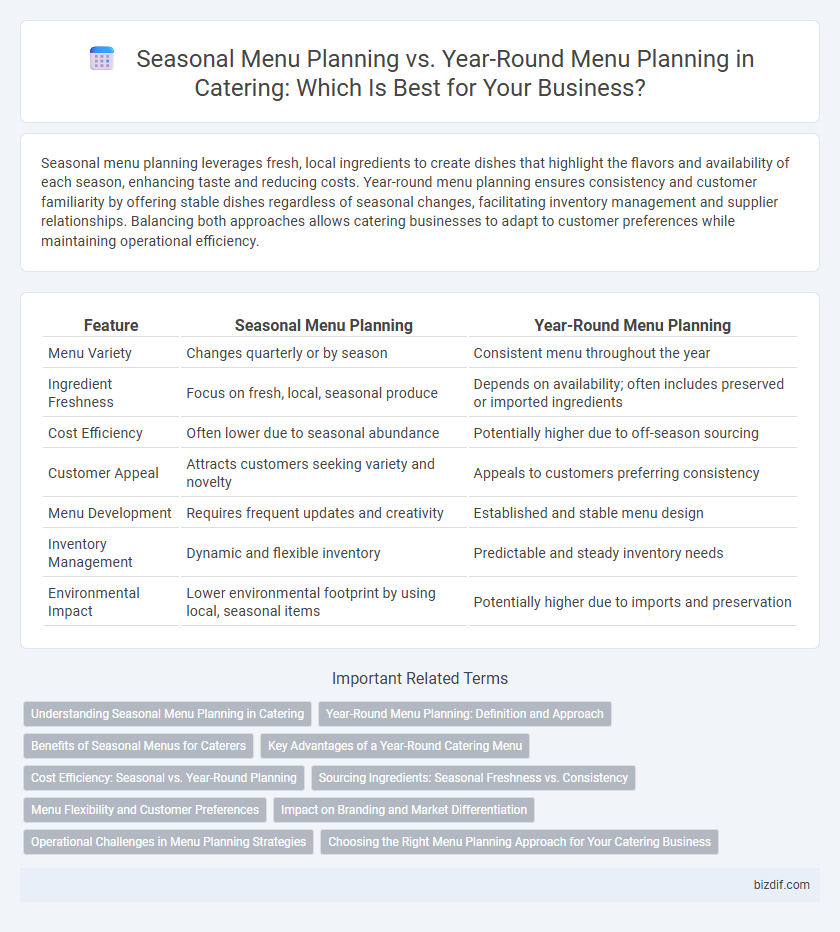Seasonal menu planning leverages fresh, local ingredients to create dishes that highlight the flavors and availability of each season, enhancing taste and reducing costs. Year-round menu planning ensures consistency and customer familiarity by offering stable dishes regardless of seasonal changes, facilitating inventory management and supplier relationships. Balancing both approaches allows catering businesses to adapt to customer preferences while maintaining operational efficiency.
Table of Comparison
| Feature | Seasonal Menu Planning | Year-Round Menu Planning |
|---|---|---|
| Menu Variety | Changes quarterly or by season | Consistent menu throughout the year |
| Ingredient Freshness | Focus on fresh, local, seasonal produce | Depends on availability; often includes preserved or imported ingredients |
| Cost Efficiency | Often lower due to seasonal abundance | Potentially higher due to off-season sourcing |
| Customer Appeal | Attracts customers seeking variety and novelty | Appeals to customers preferring consistency |
| Menu Development | Requires frequent updates and creativity | Established and stable menu design |
| Inventory Management | Dynamic and flexible inventory | Predictable and steady inventory needs |
| Environmental Impact | Lower environmental footprint by using local, seasonal items | Potentially higher due to imports and preservation |
Understanding Seasonal Menu Planning in Catering
Seasonal menu planning in catering leverages fresh, locally-sourced ingredients that are at their peak quality, enhancing flavor and nutritional value while supporting sustainability. This approach allows caterers to create dynamic menus that align with seasonal availability, reducing costs and minimizing food waste through efficient inventory management. Understanding seasonal trends enables catering businesses to offer unique, timely dishes that appeal to diners' preferences and boost customer satisfaction.
Year-Round Menu Planning: Definition and Approach
Year-round menu planning in catering involves designing a consistent selection of dishes available throughout the entire year, emphasizing staple ingredients and classic recipes that appeal to a broad audience. This approach streamlines inventory management, reduces food waste, and ensures predictability in cost control and kitchen operations. By standardizing the menu, catering businesses can maintain brand consistency and simplify staff training while accommodating occasional seasonal specials to enhance variety.
Benefits of Seasonal Menus for Caterers
Seasonal menu planning enables caterers to leverage fresh, locally sourced ingredients that enhance flavor and nutritional value while reducing food costs and waste. This approach allows for a dynamic and diverse menu that attracts clients seeking unique, timely culinary experiences tailored to each season. Emphasizing seasonal menus also supports sustainable practices, which can strengthen a caterer's brand reputation and appeal to environmentally conscious consumers.
Key Advantages of a Year-Round Catering Menu
Year-round catering menus offer consistent customer satisfaction by providing familiar and reliable dishes regardless of season, enhancing brand loyalty and operational predictability. This approach streamlines inventory management and reduces food waste by stabilizing ingredient demand and supplier relationships. Catering businesses also benefit from simplified staff training and menu marketing efforts through the uniformity of offerings throughout the year.
Cost Efficiency: Seasonal vs. Year-Round Planning
Seasonal menu planning enhances cost efficiency by utilizing locally sourced produce at peak availability, reducing ingredient costs and minimizing waste. Year-round menu planning often involves higher expenses due to reliance on imported or out-of-season ingredients, which can increase supply chain complexity and price volatility. Catering businesses benefit from seasonal menus through optimized inventory management and fluctuating demand alignment, leading to improved profit margins.
Sourcing Ingredients: Seasonal Freshness vs. Consistency
Sourcing ingredients for seasonal menu planning emphasizes fresh, locally available produce that enhances flavor and supports sustainability, often resulting in cost-effective and environmentally friendly options. Year-round menu planning relies on consistent suppliers and imported ingredients to maintain uniformity in taste and availability but may involve higher costs and less freshness. Balancing these approaches helps caterers optimize quality while managing supply chain stability and customer expectations.
Menu Flexibility and Customer Preferences
Seasonal menu planning enhances menu flexibility by incorporating fresh, locally sourced ingredients that align with customer preferences for variety and freshness throughout the year. Year-round menu planning offers consistency and reliability, catering to customers who favor familiar dishes regardless of seasonal changes. Balancing seasonal availability with staple items ensures a dynamic menu that meets diverse tastes while optimizing ingredient use and reducing waste.
Impact on Branding and Market Differentiation
Seasonal menu planning enhances branding by showcasing fresh, locally-sourced ingredients that appeal to environmentally conscious consumers and emphasize culinary creativity. It differentiates caterers in competitive markets by offering unique, evolving dishes that align with seasonal trends and customer preferences. In contrast, year-round menu planning provides consistent brand identity and reliable customer expectations but may lack the innovation and market agility that seasonal menus deliver.
Operational Challenges in Menu Planning Strategies
Seasonal menu planning demands constant adaptation to fluctuating ingredient availability, increasing supply chain complexity and requiring close collaboration with local suppliers to maintain freshness and quality. Year-round menu planning necessitates stable inventory management and consistent vendor relationships but risks higher costs due to reliance on imported or out-of-season products. Both strategies pose operational challenges in staffing, kitchen workflow, and cost control, impacting overall efficiency and customer satisfaction in catering services.
Choosing the Right Menu Planning Approach for Your Catering Business
Seasonal menu planning enhances fresh ingredient quality and aligns offerings with customer preferences, boosting appeal during specific times of the year. Year-round menu planning ensures consistency, streamlines inventory management, and builds brand identity with signature dishes available at all times. Selecting the right approach depends on your catering business size, location, supplier reliability, and target market demands.
Seasonal menu planning vs Year-round menu planning Infographic

 bizdif.com
bizdif.com